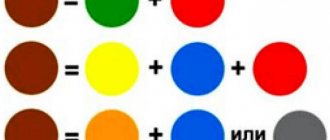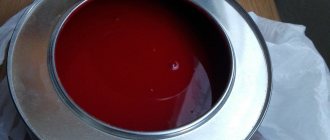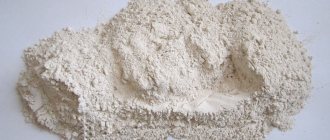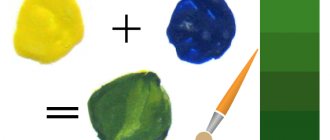What colors are composite?
Red, yellow and blue are the primary colors, or primary colors. By mixing the primary colors in pairs in equal proportions, you can get composite colors - orange, green, and purple.
Interesting materials:
How to change the language on Instagram to Russian on your phone? How to change the language in Chrome on your phone? How to change the language in Zoom on your phone? How to change the keyboard on a Huawei phone? How to change phone memory to memory card on Android? How to change your account password on your phone? How to change Gmail password on phone? How to change the password on an ASUS router via phone? How to change your Insta password via phone? How to change the password on a Samsung phone?
Features of gray color
Gray color is distinguished by its richness of shades - there are more than 250 of them. Being neutral in a classic design, it creates a universal background for chromatic colors. This contrasting technique is often used by artists, decorators, costume and interior designers.
Gray tones have a unique effect on the psycho-emotional sphere of a person, creating a calming effect and suppressing excessive manifestations of feelings. They promote concentration and activation of the intellect.
They are most often used to decorate offices, scientific laboratories, hospitals, and hallways. Fashion trends of high-tech and minimalism are almost entirely built on the inclusion of shades of gray.
However, excessive use of color can lead to depression. Therefore, it is advisable to use it in combination with chromatic shades.
Warm and cool colors
Let's first become familiar with the color wheel and define "warm" and "cool" colors. You may already be familiar with warm and cool colors, but if not, let's break it down.
A color wheel is a color spectrum closed in a circle. Certain color relationships arise as a result of this bending.
Warm colors are colors that we associate with hot things. For example, the sun is hot and we know that its color is yellow or orange. The fire is also hot, and again its color is yellow or orange. That's why yellow and orange are warm colors.
Cool colors are colors that we associate with cool things. For example, ice and snow are cold, and the color of shadows on ice or snow is blue. Therefore, blue is a cool color.
This concept is called color temperature.
Cool colors range from blue-green to blue-violet. Warm colors - from yellow-green to red-violet.
Green and purple can be considered transitional colors. If purple has more red in it, it can be considered a warm color. If it has more blue in it, it is a cool color.
Green is another transitional color. If it has more blue, then it is cool. But if it contains more yellow, then it is considered a warm color.
Okay, now that we've established that, let's see how this information can be applied to the color gray.
Gray color is considered neutral. But as you'll see in a moment, it's not quite as neutral as you'd expect. There are no neutral colors on the color wheel. Other neutral colors include black, white, and some browns (though most browns are a color like orange.)
Gray is mixed by combining white and black. White cannot be mixed - it is an absolutely pure color. But many black ones can be obtained. And this is exactly how we experiment to get a gray tint. The key is in the blackest shade.
Making gray from watercolor and gouache
The greatest scope for the artist's imagination opens up when using water-based dyes, such as gouache or watercolor.
In addition to chromatic combinations based on the colors presented in the palette and mixing black and white, water can be used to achieve the desired result.
With its help, the resulting shade is lightened to the required brightness, and delicate intermediate tones are created to obtain harmonious color transitions.
Created by simply diluting black, watercolor shades look flat and not painterly. While the shades of gray obtained as a result of chromatic combination have volume, depth and are close to those observed in nature.
Watercolor painting with a predominance of gray shades
To create a rich gray shade, you need to combine any blue tones with any brown.
The final results vary due to the chosen quantitative proportion of the components, and also depend on the surrounding color scheme. A prerequisite is to mix no more than 3 colors. Otherwise, the shade will turn out dirty, and correcting the mistake will take a lot of time.
Preparing paint for the walls
Before you start treating the walls, you need to decide on the type of paint for a particular room. Each type has its own number of advantages and features that are worth considering when making a choice.
- alkyd;
- water-dispersed;
- polyurethane.
It should be noted that the use of water-dispersion paints greatly facilitates the task. In this case, there is no need to mix anything to make a beige color. The paint is initially completely white, its color easily changes when mixing paints with colors.
Polyurethane mixtures provide significant wear resistance of the coating, resistance to destructive influences and long-lasting color.
Laws of color mixing
To obtain new tones when mixing paints, you need to familiarize yourself with the basic rules of color, which are invariably observed in construction, design, and painting. According to science, there are chromatic colors - bright, colorful shades, as well as achromatic ones - gray, white, black.
The ash shade is unique in its own way. Any chromatic color has an additional tone, when combined with which it forms gray. This is the first law of color mixing. Other recommendations are:
- when combining two primary colors that are closer in a circle than additional ones, the new shade will be located between them in tone along a smaller arc of the circle;
- two colors when combined make it possible to obtain a shade that is always intermediate in chromaticity between the original ones;
- when mixing two tones of equal chromaticity, the same color will be obtained, regardless of the spectral composition of the original ones.
Color mixing options to create shades of gray
When renovating a room, mixing black oil paint with white is the easiest and most effective way to achieve gray. But we must take into account that when drying, the color acquires a deeper saturation and becomes darker. Therefore, before starting work, the composition should be tested on a similar surface. One shade used on walls of different materials or textures can produce different visual effects.
To create more “live” tones you should:
- add a drop of blue or green to the created mixture to obtain cold mother-of-pearl;
- introduce a little yellow or ocher, which creates the illusion of warm ash;
- use antimony to give a metallic, silvery tint;
- combine gray with pink, thereby achieving a spectacular ash-copper tone.
ways to obtain different shades of gray
Working with paints from two or more manufacturers at the same time is not allowed. They vary in consistency, density and brightness, and this reduces the quality of the resulting mixture. The final adjustment of the color is made by adding a few drops of white to lighten or black pigment to obtain a darker shade.
Scheme for obtaining different shades of gray
General information
To obtain the desired color, you can practice “alchemy” by mixing available shades. These recommendations are suitable for both painters and artists, and those who decide to take repairs into their own hands. The beige shade often comes to the rescue in solving many design problems. Thanks to it, you can get quite attractive and extraordinary design projects.
Read also: Comparison table for RR and RAL colors
Attention! Beige tones transform rooms of any size and purpose quite well.
It is recommended to dilute the color scheme with bright and contrasting options, and decorate only the walls in beige tones. Despite the obvious advantages of the color in question, you should not get too carried away with it when decorating the interior. In some cases, it may seem uncomfortable, and the atmosphere will begin to become boring. In addition, it is necessary to take into account the lighting features in the room.
So, what shades should you mix to get beige?
How to get light green color from paints
There are many options for making light green from different paints. For work, in addition to colors, you need a white palette, brushes and a palette knife, a jar for water, and paper napkins for cleaning tools. The easiest way to create a lighter green tone is by adding white to the finished green paint. The latter can also be created with your own hands: mix blue and bright yellow in equal proportions.
Using white paint it is easy to lighten any green shade that is available. But most often it turns out not juicy enough, without the characteristic light green yellow. In this case, a little yellow color is dripped into the paint and mixed thoroughly until a uniform light green color is obtained.
Variety of green
The original green is usually presented in all sets; if the required dye is not available, there are no problems obtaining it. Pairing yellow with blue gives the desired green background. But any direction of creativity, be it painting, interior design or another option for decorating objects, requires a wide palette of green. The basic principle of all experiments is to change the proportions of the base colors; white or black dye is used to lighten or darken the background.
Next we will talk about mixing options and the results of the experiment:
- The combination of blue and yellow with a small addition of brown represents khaki. Green with a small amount of yellow forms olive.
- Traditional light green is the result of mixing green and white. Adding yellow or blue will help regulate warmth.
The circle demonstrates a variety of green colors. The base dye is located in the center, followed by the additional component, and then the result of mixing. The last circle is experiments of the resulting tone with the addition of white and black dye.











